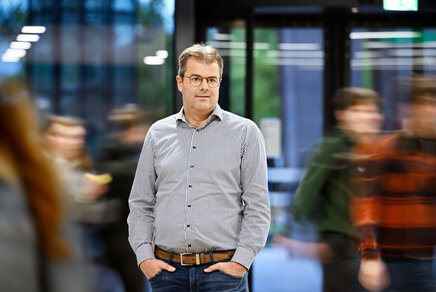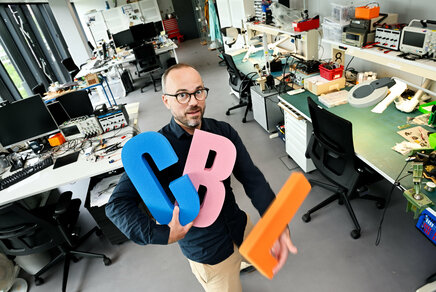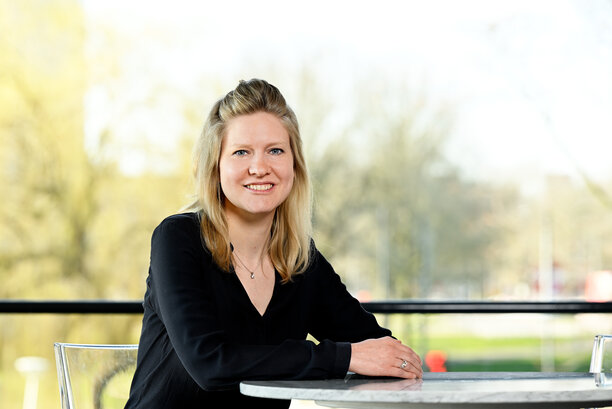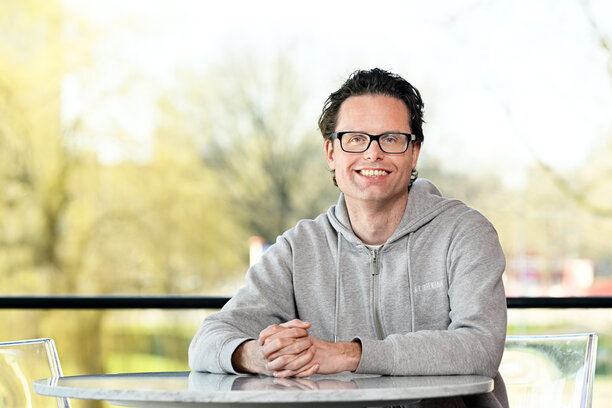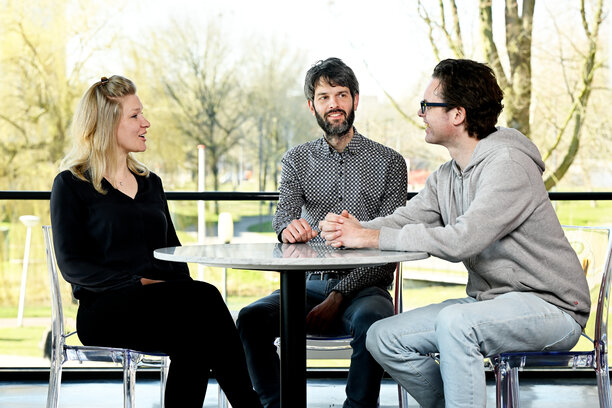‘The Young Academy takes you out of your hard sciences bubble and opens doors’
Jim Portegies is the tenth member of the TU/e community to join the prestigious Young Academy of the Royal Netherlands Academy of Arts and Sciences (KNAW).
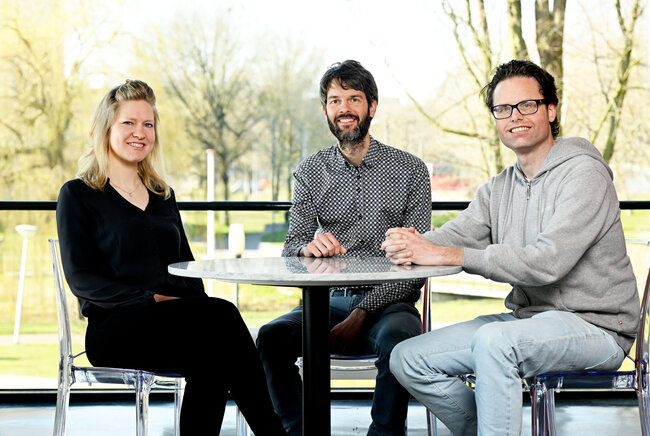
Mathematician Jim Portegies is the tenth person at TU/e to join the select company of the Young Academy of the KNAW. His colleagues in Eindhoven Tom de Greef and Liesbeth Janssen have been members of this national platform for young top-flight scientists in all kinds of disciplines since 2020, and they joined Portegies for this interview. “It is a unique platform, with an independent voice, that broadens your own view and your view of the academic world,” says Janssen.
Carlijn Bouten, Jan van Hest, Mark Peletier, Bettina Speckmann, Maaike Kroon, Johan van Leeuwaarden and Patricia Dankers. These TU/e alumni of the Dutch Young Academy (DYA) are names of no mean standing to have preceded Liesbeth Janssen, Tom de Greef and Jim Portegies as members of the Young Academy of the Royal Netherlands Academy of Arts and Sciences. Without exception, these are talented, highly driven researchers – all now holding the rank of professor. That it is an honor to join this company is evident, as Janssen, De Greef and Portegies agree unanimously.
“It carries a certain degree of prestige,” says Tom de Greef, associate professor of synthetic biology at the Department of Biomedical Engineering, of membership of DYA. Candidates for DYA are nominated in university circles by the rector magnificus. “It is an honor to be asked. And it looks good on your résumé. But for me personally the added value lies in the fact that you get to talk about science with researchers working in completely different fields. I am your regular hardcore hard sciences researcher; at the Young Academy you are surrounded by totally different scientists. This interdisciplinarity gives rise to entirely different discussions,” says De Greef.
What is the Young Academy?
The Young Academy has been in existence since 2005 and has fifty members, all of whom join for a period of five years. Every year ten new members join, and ten members leave. New members are top-flight scientists in various disciplines who have gained their doctorate no more than ten years previously.
DYA members organize activities relating to four themes: content and interdisciplinarity, science policy, science and society, and internationalization. Scientists discussing science, in other words. One of the aims of DYA is to foster interdisciplinary research, which it does by bringing together researchers in all kinds of fields. It also provides scientific organizations and ministries with advice on science policy.

Out of your bubble
“You are drawn out of your own bubble, no doubt about it,” Liesbeth Janssen agrees, associate professor at the Department of Applied Physics. “And that in itself is one of the most enjoyable aspects of membership. You have discussions on themes that here at the university we see from a hard sciences perspective, without even realizing it. Take diversity, for example, at TU/e we often talk about this based on what we see around us, but at the Young Academy I discuss this with social scientists who are researching the issue. This makes the discussion is a lot more interesting, and I gain new insights.”
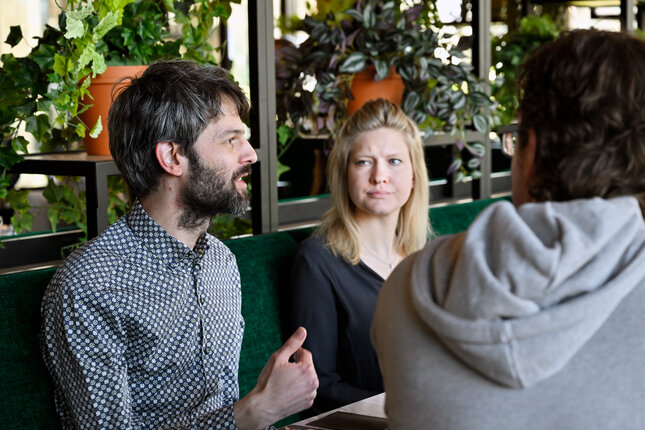
When Jim Portegies, assistant professor at the Department of Mathematics & Computer Science, is sworn in as a member of the Young Academy, on March 22nd in the Trippenhuis in Amsterdam, he will be one experience richer than Liesbeth Janssen and Tom de Greef. They have been Young Academy members for two years now but due to the corona pandemic were sworn in online to this company of young top-flight Dutch researchers. “We were introduced to the KNAW board in the Trippenhuis, but we gained membership via Zoom. The Trippenhuis is such a beautiful historic building and a special place. My parents were disappointed not to be able to attend my admission ceremony,” Janssen explains.
A member and then what?
And then you are part of a fifty-strong group of talented, passionate young researchers, drawn from all kinds of universities and research institutions. And then? “I didn’t actually have a good idea of what DYA does, but now that I’m a member, I can see how many projects and activities there are,” says Janssen. A couple of times a year a general members meeting is held, there are also work groups and anyone can start an initiative, or join an existing activity on one of the themes. “I’m in the Diversity and Inclusion work group, and we are researching whether certain ethnic groups are underrepresented within the academic world. Another work group is comparing the requirements for tenure track across all Dutch universities.”
I get such an energy boost from sparring with other members of the Young Academy
Liesbeth Janssen, associate professor at Applied Physics and DYA member
Janssen continues, “Every time I attend a meeting with people in DYA, I get an energy boost. And I can’t say that of all the meetings I attend in my day-to-day work,” she says with a wink. “DYA is a unique platform with an independent voice that broadens your view of the academic world.”
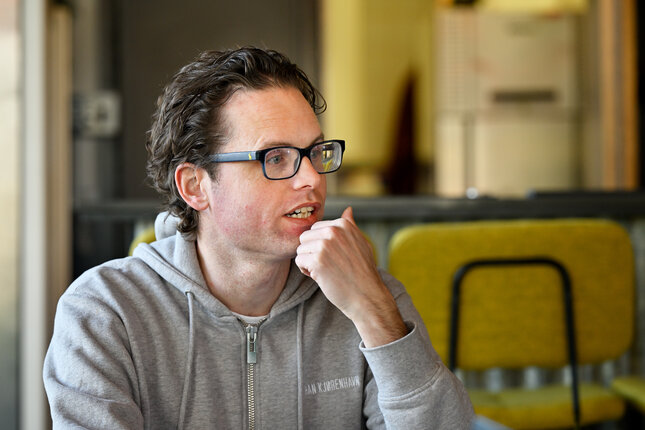
Recognition and Rewards
Noises from DYA are noticed, observes De Greef - by politicians, for example. He is a member of a work group concerned with the new system of Recognition and Rewards for scientists. “So, for example, we’ve just been in contact with someone from the Lower House who plans to ask parliamentary questions on this subject. Your opinion is more likely to be noticed if it comes from within the Young Academy.”
De Greef is bothered mainly by the downplaying of the competitive element within Recognition and Rewards, while this is the very thing that Janssen welcomes. Janssen, “I believe that in the academic world we have gone overboard in making research funding a competitive process. It’s outdated. Everyone hired at our university as a lecturer has by definition been trusted to conduct research and to teach. And so they should be given the resources to do just that, a basic funding of sorts. Science is not a competition, that serves only to breed mistrust among academic staff.”
De Greef sees science as elite sport and competition for funding as essential - although he too believes that the likelihood of having a proposal accepted is much too low. “The competitive element ensures that I write up my ideas and objectives better, that I have to think about what my next step will be. I am against handing out money to all and sundry, no questions asked. In time that would only diminish the quality of research.”
I’m happy to disagree with someone and like to have a good discussion
Tom de Greef, associate professor at Biomedical Engineering and DYA member
The lively discussion we sit down to reveals that like anywhere else, the Young Academy is home to differing views. “Now and again we have some intense clashes within the DYA Recognition and Rewards work group, because I don’t share the opinions held by the others,” says De Greef, smiling broadly. “The noises coming from within DYA are pretty uniform, whereas I’m happy to disagree with someone and like to have a good discussion.”
Within the project group, De Greef will be studying why doctoral candidates do or don’t want to pursue a career in science. The Eindhoven Young Academy of Engineering, of which De Greef, Janssen and Portegies are also members, studied this matter last year at TU/e, and now DYA is picking this up and expanding it nationwide. “The Eindhoven study revealed that doctoral candidates see supervisors having a tough time, that it is difficult to get funding and that they can earn much more at ASML. Which makes them think why go into science? We want to extend this study to include the humanities and social sciences. We’ll be interviewing a great many doctoral candidates this year on this subject to further our understanding. This is something I enjoy being involved with.”
Stepping up to higher education
Portegies is chiefly interested in hearing the views of his fellow DYA members working in other disciplines on matters he considers important. He plans to focus on improving the cooperation with secondary education and the transition to university. “I see that students often arrive with us not knowing quite enough. In response we can say ‘this is what we want’, but we have little experience of secondary education. We need to do some bridge building here. I’d like to do that within DYA by completing an internship within secondary education.”
I see a lot of colleagues struggling – I myself struggle. It’s difficult to talk about, even though we really must
Jim Portegies, assistant professor at Mathematics & Computer Science and new DYA member
Another important theme for them is well-being. The well-being of both students and employees. “I see that first-year students of math often find the work difficult. They think they are not smart enough, that they can’t do it. I talk to them about this and try to get them to set their insecurities aside for a while, so that they can concentrate on the math. I teach very intuitively, but there are also people for whom this is their field and they see things differently. I hope within DYA to learn from their approach,” he says.
Portegies continues, “I also see a lot of colleagues struggling, for example with their workload and the fear of not being good enough. Over time this is detrimental to the quality of our work. It’s something I myself struggle with, but it is still a taboo subject. Yet what we really want is to have people discussing this openly. So a culture change is needed and within the Young Academy I hope I can get things moving.” “It’s good that you’ve picked up on this,” says Janssen, approvingly.
Janssen has one last tip for newcomer Portegies: “It is a privilege to have the opportunity to work with so many interesting people on themes close to all our hearts. Now you are in a position to make a difference. Go for it!”
TU/e alumni of DYA about their time at DYA
Since its founding in 2005, the ranks of the Young Academy have included ten TU/e researchers. These are Carlijn Bouten (2005-2010), Jan van Hest (2005-2010), Mark Peletier (2006-2011), Bettina Speckmann (2010-2015), Maaike Kroon (2012-2017), Patricia Dankers (2015-2020), Johan van Leeuwaarden (2015-2020), Tom de Greef (2020-2025), Liesbeth Janssen (2020-2025) and Jim Portegies (2022-2027).
Full Professor of mathematics Mark Peletier joined the Young Academy from 2006 until 2011. “The thing I most benefitted from was the high-level interaction with scientists in very different disciplines. That really opened up my eyes. And I remember being hugely impressed by the quality of these people and how capable they were.”
Jan van Hest, Full Professor of bio-organic chemistry, was among DYA’s first cohort in 2005. “We were given a free hand to shape DYA. We chose three themes we wanted to actively engaged with – science policy, career development and science communication. I was involved with the last of these. We developed a program built around food and we filled a large American school bus with DYA members and toured high schools to show the pupils, in a lighthearted way, that science is fun and interesting. I immediately got to know my DYA colleagues better, saw how passionate they were about their field of work. I still bump into my former DYA colleagues. The bond you form at the start of your career stands the test of time!”
Full Professor of regenerative medicine Carlijn Bouten was also among the first cohort. “It felt to me as if a new wind was blowing through science thanks to us, with the strange new zest we had, and our sometimes unconventional methods.”
“Up to that point, my training in various fields and my research had always been multidisciplinary, but here I had the opportunity to extend my interests and insights even further. I became a lot more capable of viewing my own field - regenerative medicine – from the perspective of other research fields.”
“But what most influenced me was finding myself among a group of researchers of my own age, at the same stage of their career, with the same interests and drive – and setbacks! – who were keen to and did work together to achieve something. And so I think it makes valuable sense to set up academies like this at individual universities and to provide scope for individual younger researchers to develop in this way, enabling them to ponder together in realms beyond the boundaries of their own field and to influence research directions, education, policy, regulations, collaboration, career prospects and so on.”
More on our strategy

